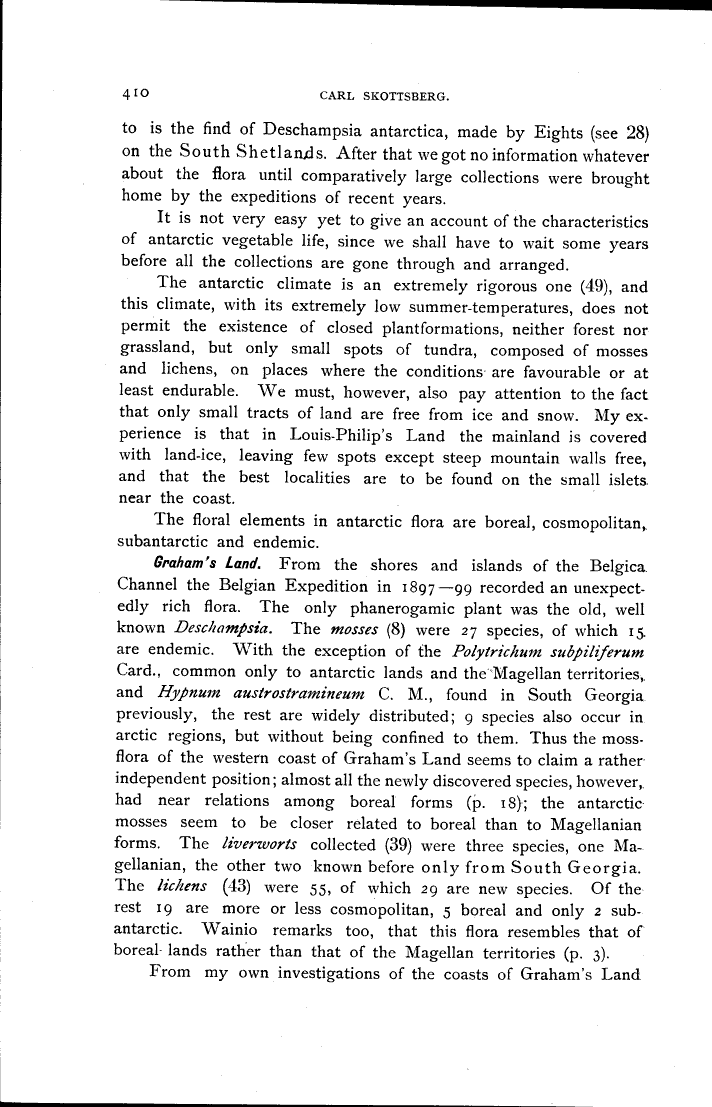
Full resolution (TIFF) - On this page / på denna sida - Some remarks upon the geographical distribution of vegetation in the colder Southern Hemisphere. By Carl Skottsberg. Botanist of the Swedish Antarctic Expedition 1901—1903. With 2 maps, tabl. 8 and 9. - General survey of the austral of or palæooceanic (Engler) realm. - I. The antarctic dominion.

<< prev. page << föreg. sida << >> nästa sida >> next page >>
Below is the raw OCR text
from the above scanned image.
Do you see an error? Proofread the page now!
Här nedan syns maskintolkade texten från faksimilbilden ovan.
Ser du något fel? Korrekturläs sidan nu!
This page has never been proofread. / Denna sida har aldrig korrekturlästs.
410 CARL SKOTTSBERG.
to is the find of Deschampsia antarctica, made by Eights (see 28)
on the South Shetlanjds. After that we got no information whatever
about the flora until comparatively large collections were brought
home by the expeditions of recent years.
It is not very easy yet to give an account of the characteristics
of antarctic vegetable life, since we shall have to wait some years
before all the collections are gone through and arranged.
The antarctic climate is an extremely rigorous one (49), and
this climate, with its extremely low summer-temperatures, does not
permit the existence of closed plantformations, neither forest nor
grassland, but only small spots of tundra, composed of mosses
and lichens, on places where the conditions are favourable or at
least endurable. We must, however, also pay attention to the fact
that only small tracts of land are free from ice and snow. My
experience is that in Louis-Philip’s Land the mainland is covered
with land-ice, leaving few spots except steep mountain walls free,
and that the best localities are to be found on the small islets
near the coast.
The floral elements in antarctic flora are boreal, cosmopolitan,,
subantarctic and endemic.
Graham’s Land. From the shores and islands of the Belgica
Channel the Belgian Expedition in 1897-99 recorded an
unexpectedly rich flora. The only phanerogamic plant was the old, well
known Deschampsia. The mosses (8) were 27 species, of which 15
are endemic. With the exception of the Polytrichum snbpiliferum
Card., common only to antarctic lands and the’Magellan territories,,
and Hypnum austrostramineum C. M., found in South Georgia
previously, the rest are widely distributed; 9 species also occur in
arctic regions, but without being confined to them. Thus the
moss-flora of the western coast of Graham’s Land seems to claim a rather
independent position; almost all the newly discovered species, however,,
had near relations among boreal forms (p. iS); the antarctic
mosses seem to be closer related to boreal than to Magellanian
forms. The liverworts collected (39) were three species, one
Magellanian, the other two known before only from South Georgia.
The lichens (43) were 55, of which 29 are new species. Of the
rest 19 are more or less cosmopolitan, 5 boreal and only 2
subantarctic. Wainio remarks too, that this flora resembles that of
boreal- lands rather than that of the Magellan territories (p. 3).
From my own investigations of the coasts of Graham’s Land
<< prev. page << föreg. sida << >> nästa sida >> next page >>